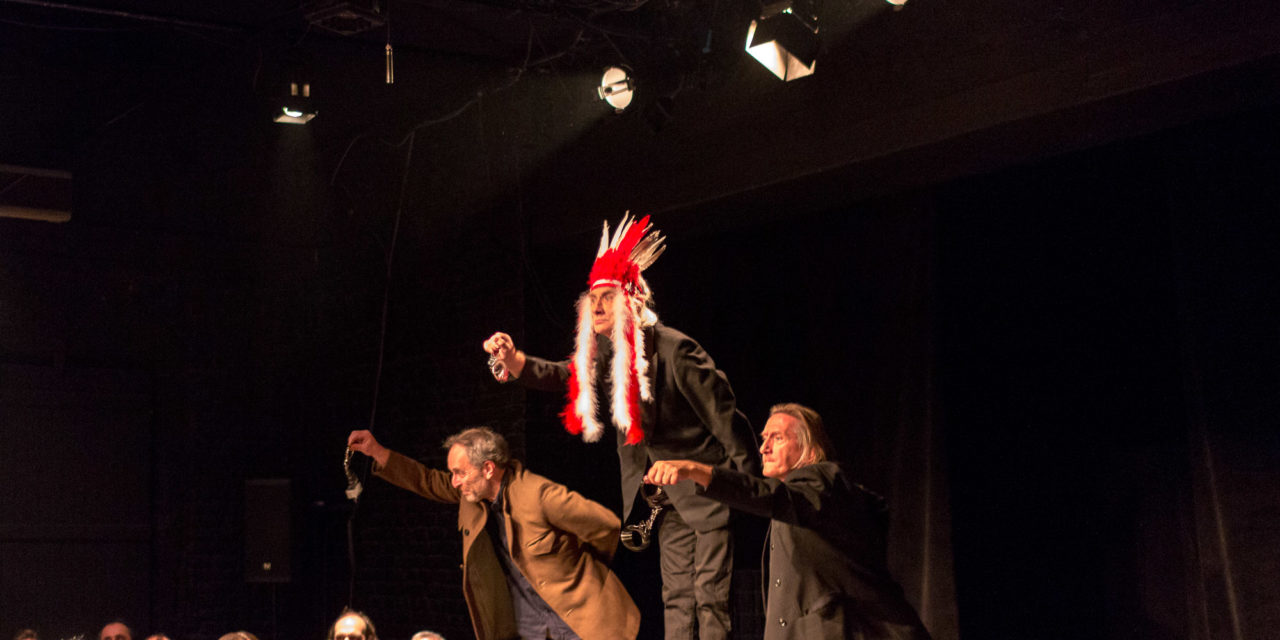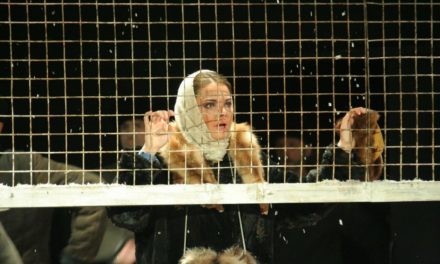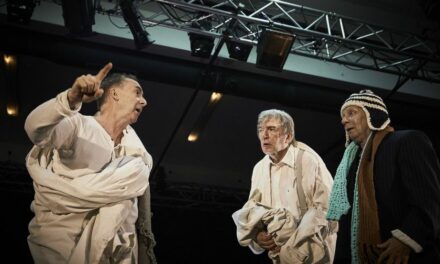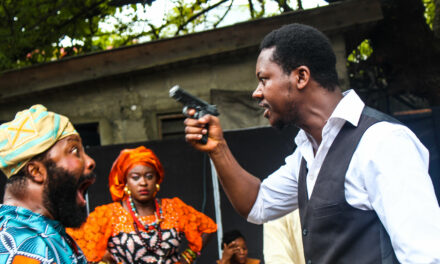The Theatre of the Eighth Day’s Paragraph 196 (exercises on terror) (Paragraf 196 kk (ćwiczenia z terroru)) places the viewer in the mental centre of today’s Poland.
Paragraph 196 as a socio-political diagnosis
The title refers to a quite controversial paragraph of the Polish Criminal Code, detailing punishments for offending religious feelings. In Poland, artists were put on trial based on this paragraph. In Poland, criminal proceedings were imposed on artists based on this paragraph. One of the creators of the performance is Paweł Hajncel, a performer critical of the Catholic Church. His performances accompany religious processions. Hajncel appears during them as a Butterfly, Christ, or a woman wearing a dress and holding a banner: “Women! You do not have any rights in the Church!”
Paragraph 196 is a critical analysis of changes that have taken place in Poland over the last few years. He asks a question about the condition of politicians and society.
Poland, the leader of democratic changes in Central Europe, building the open society for the last 30 years, after the last presidential and parliamentary elections has succumbed to populism and nationalism. The actors of the Theatre of the Eighth Day make a painful diagnosis.
In the performance we can sense the artists’ convictions about the Catholic clergy’s domination of public life. Upon entering the building of the theatre, spectators are led by Chaplain of the Main Entrance, then by Chaplain of the Mezzanine, Chaplain of the State Forests, and finally in the hall by Chaplain of the Alternative Theatre. The Chaplain of the State Forests presents woodworms in the jar. It is a reference to the dispute between the Polish government and the European Union about felling trees in the Białowieża National Park. The Chaplain of the State Forests also recalls the danger of commissioning Article 7 of the Treaty on the European Union against Poland, because of the violation of the principles of a democratic state of law. A voice from the loudspeaker greets the chaplains and tells them about the cash gifts waiting in the theatre office. This is an allusion to the Polish government granting large financial subsidies to the Catholic Church. After entering the theatre room, the actors seat viewers in the relevant sectors in the audience and comment: “It’s just an improvisation, it’s superficial, unjust, biased . . . maybe even not cultural . . . certainly biased, certainly not exhausting the subject . . .” The Grey Sister informs the spectators that they are at a private party, beyond the reach of the censorship and without the appropriate imprimatur (consent) of the Church.
“Treacherous snouts” and the Smoleńsk-Monthly
In the first scene, the president enters wearing a white-red Indian headdress; he is surrounded by his followers. He begins a monologue with the phrase “Welcome treacherous snouts”. This is an unambiguous reference to the leader of the ruling party, who referred in this way to the opposition during the debate on the act limiting the independence of the judiciary. The man who has been ruling Poland for over two years. Another scene evokes the so-called Smoleńsk-Monthly. It takes place every month to commemorate the airplane crash of April 10, 2010. On that day, the Polish president, his wife and 94 representatives of the political elite died. They flew to Katyń to take part in the commemoration of the 70th anniversary of the Soviet murder of officers of the Polish Army taken prisoner during the war in 1939. In 1940, Stalin ordered the murder of over 20,000 Polish officers. The overlap of the memory of one of the largest national traumas with an airplane crash caused a deep break in the Polish mentality. Theories have been made about a terrorist attack by the Russians (bombs on board, shooting down of the plane). The dispute over the causes of the Smolensk catastrophe has effectively destabilized the situation in Poland. This fact serves as a pretext for the current government to organize memory marches each month. They are aimed at mobilizing and integrating adherents. The leader of the ruling party plays the role of priest of the Smoleńsk religion. The elements of the ritual are his speeches, full of hatred for the political opposition and the liberal part of society. His speeches are full of xenophobia. They are an important element of exercising power through conflict.
The next scenes recall the rituals of the Polish leaders’ hatred towards social elites: doctors, lawyers. Terror is directed by the Grey Sister, evoking the title character in Stanisław Ignacy Witkiewicz’s drama The Madman and the Nun (Wariat i Zakonnica). The perpetrators bend the necks of the accused. They place handcuffs on their hands. They encourage spectators to shout: “Thieves, thieves, thieves! Hang them!” This scene refers to the governmental billboard campaign. The authorities informed the public about corruption among the judges. The charges were as absurd as stealing €10 , pants, or a piece of sausage (sic!). The victim of the next show of hatred is a feminist (played by a man). She enters the patriarchal role of the wife of the conservative politician. She is humiliated and beaten by him, forced to have sex. This scene recalls an authentic scandal several months ago. This is also an allegory of the conservative vision of the role of women in the family and society. The ritual of patriarchal submission is accompanied by the actor’s lecture on natural methods of fertility control. As you know, the Catholic Church is against contraception.
![<em>Paragraf 196 kk (ćwiczenia z terroru)</em> [<em> Paragraph 196 (exercises on terror)</em>], Teatr Ósmego Dnia [Theatre of the Eight Day], Photograph by Max Małecki.](https://thetheatretimes.com/wp-content/uploads/2018/03/5.-Paragraph-196-exercises-on-terror-1024x682.jpg)
Paragraf 196 kk (ćwiczenia z terroru) [ Paragraph 196 (exercises on terror)], Teatr Ósmego Dnia [Theatre of the Eight Day], Photograph by Max Małecki.
Dealing with the Catholic Church
After the monologue about the female fertility cycle, the time has come to conceive a child. In the next scene a Pole is born. A nationalist and a faithful Catholic. The Pole-Catholic is a semantic concept introduced more than a hundred years ago by Roman Dmowski, the creator of Polish nationalism. The birth of a Pole takes place at the Baltic Sea. The birth itself is hidden behind the beach screen. Characteristic attributes of Polish beaches are screens and umbrellas. Each group of vacationers separates from the others, creating its own world. This is an allegory of divided Polish society. The birth of a Pole is accompanied by a pure nonsense song that is sung by the audience.
After the patriotic exaltation, bishops enter the stage. The actors speak authentic fragments of speeches given by the dignitaries of the Catholic Church in Poland. They contain anti-Semitic, xenophobic and sexist subjects. One of the bishops is trying to justify the cases of priest paedophiles. . . the guilt of the children themselves. This statement caused indignation in Poland. Laughter arouses a quotation from a speech by an important person of the Church hierarchy: “The church does not forbid love (. . .) for homosexual people. They can love! But not people of the same sex.” Two bishops stand guard over the patriarchal model of the family and the traditional role of women and men as the only one permissible. They recognize feminism as heresy: “Gender studies prevents the realization of the divine plan of human salvation.” The priest with xenophobic views screams: “This is an invasion. Most of these invaders are young and strong people. They come for high benefits pay. According to Islam, it is a tribute paid by unfaithful dogs in exchange for leaving Christians alive.” There are also declarations glorifying fascism, the rule of Mussolini in Italy, Franco in Spain or the authoritarianism of Salazar in Portugal. Bishops emphasize the merits of dictators for Catholicism and anti-communism.
In Polish public debates, the above speeches of the clergy of the Catholic Church appeared in different times and places. However, their citation in the theatre space evokes impressions. It emphasizes the scale of prejudices, hostility, aversion towards “another”. Of course, this is not a complete vision of the mentality of the Christian Church. The choice of speeches is subjective. However, it highlights the scale of the problem. And that is its value.
Only one of the bishops stays on the stage. After a moment the General joins him, a representative of dictators. The Bishop is Alois Hudal, an adherent of Nazism and author of the book Die Grundlagen des Nationalsozialismus (1936). After the Second World War, as a high official of the Vatican, he became involved in helping Nazi criminals. He organized “ratlines”, allowing them to escape to South America. He collaborated with the secret organization of the former ODESSA SS men. The Nazi activities of Hudal and the Archbishop of Vienna, Cardinal Theodor Innitzer, are dark sides of the Catholic Church. The critique of the Vatican presented in the performance can be regarded as one-sided. Artists do not notice the renewal of Catholicism, which was the Second Vatican Council. Changes in doctrine and Catholic social teaching. Declared new relationships with Judaism, other religions and agnostics. Apology for a not-always-glorious past. But theatre is not an academic debate. The Theatre of the Eighth Day indicates the problems still unresolved. For many Catholics it is a lack of tolerance and hostility towards an open society. A longing for the times of the Council of Trent (16th c.), when the Catholic Church considered itself the guardian of the truth. And its only interpreter.
“A lesson” in nationalism
After the flirt between Bishop and the General, the action returns to contemporary Poland. The Grey Sister opens up a shooting shield and paraphrases the text of an article from a nationalist internet portal. The shooting range becomes a place of integration of Poles-Catholics, a lesson in nationalism. Poles raised in this way create a paramilitary squad. The soldiers of the Territorial Defence Force enter the stage. It is the defensive unit that the current government has established, consisting of volunteers (Poland has a professional army). In theory, this is a tribute to Polish uprising traditions. However, its soldiers are recruited from paramilitary, nationalist organizations. The opposition fears that the Territorial Defence Force brigades can be used against civil protest movements that were started in Poland after the 2015 elections.
Soldiers start their exercises on stage and shout military commands. In the finale of the spectacle spectators are surrounded by a wire mesh fencing. The process of enslaving society is underway. A man in a black shirt exclaims nationalistic and xenophobic slogans: “there is no Polish nationalist without radical Catholicism; (. . .) with satisfaction I see how this old, wrinkled HIV-infected European Union is dying, Marxist, cosmopolitan Deviant, multi-cultural (. . .) Traitors in cassocks, bastards of communism, Freemasons (. . .), supporters of Islamization in Poland (. . .).”
After the cries stop, silence falls. A galley proof burns on an empty stage. Is it smoke from the burning of “non-legitimate” books? A symbol of rotten, liberal culture? The words of pastor Martin Niemöller, a prisoner of Dachau, can be heard in the silence:
First they came for the Communists, and I did not speak out
Because I was not a Communist.
Then they came for the Socialists, and I did not speak out
Because I was not a Socialist.
Then they came for the Trade Unionists, and I did not speak out
Because I was not a Trade Unionist.
Then they came for the Jews, and I did not speak out
Because I was not a Jew.
Then they came for me
and there was no one left to speak for me.
The performance Paragraph 196 (exercises on terror) is a great warning. It is not only directed at Poles. A warning against nationalism, anti-Semitism and xenophobia. It is voiced by artists who are socially and politically involved. They represent theatre that for over 50 years protests against authoritarianism. And against ordinary stupidity. The production recalls Franck Pavloff’s novel Matin brun (Brown Morning).(1) The actors of the Theatre of the Eighth Day seem to say: there is still time, there is still time. . .
Paragraph 196 (exercises on terror)
Scenario and direction: The Theatre of the Eighth Day
Cast: Ewa Wójciak, Adam Borowski, Tadeusz Janiszewski, Marcin Kęszycki, Jacek Chmaj and Paweł Hajncel (performer, “Butterfly from Łódź”)
Music: Jakub S.
Voice: Wiesław Zanecki
Costumes: Izabela Rudzka
Premiere: 2015.12.15
Notes
1. Pavloff, F. Matin brun (Paris, 1998).
This post was written by the author in their personal capacity.The opinions expressed in this article are the author’s own and do not reflect the view of The Theatre Times, their staff or collaborators.
This post was written by Klaudiusz Święcicki.
The views expressed here belong to the author and do not necessarily reflect our views and opinions.


















